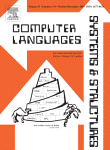 Authors: Thierry GAUTIER, Hamid-Reza HAMIDI
Authors: Thierry GAUTIER, Hamid-Reza HAMIDI
Affiliation: Laboratoire ID-IMAG
Reference: Computer Languages, Systems & Structures 33 (2007), pp. 168 – 178
Abstract: “RPC-based grid infrastructures emphasize on the composition of services on a large number of computing resources. The key issue to reach high performance is to enable exploitation of parallelism on services invocations and communications. Moreover, this process should be transparent to reuse legacy codes. In this paper we present HOMA, an IDL compiler and a run-time support for automatic detection of the parallelism of invocations and their data dependencies on a set of CORBA objects. On homogeneous architecture, HOMA is accompanied by a predictable cost model. In the case of an application with a small critical path, among p processors the speed up of HOMA versus CORBA is asymptotically O(p). The illustrations on a case study in computational chemistry validate our cost model.”
Comments: the authors mention briefly CAPE-OPEN in one sentence “CAPE-OPEN [10] is an European project that aimed to propose CORBA interface of components for high performance simulation environments in computer aided process engineering.”. They reference the paper / presentation made at ESCAPE-12 that explained the status of CAPE-OPEN back in 2002. The fact that the CAPE-OPEN standard has been offered in a CORBA version along with a COM version is used to strengthen the case made by the authors to focus on CORBA.
CO-LaN welcomes the reference made and the implicit consideration of the large potential CAPE-OPEN is bringing. However using CORBA as middleware for CAPE-OPEN has never been very developed. For obvious market reasons, it is the COM version which has been mostly used. By proposing a specific CAPE-OPEN middleware, COBIA, CO-LaN is in fact progressively abandoning references to CORBA or COM, even if this will take years.
